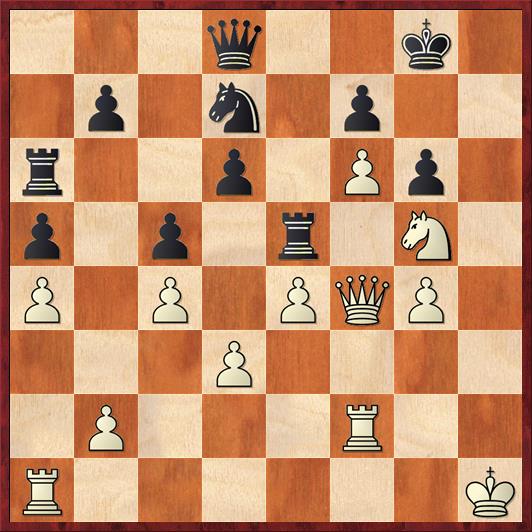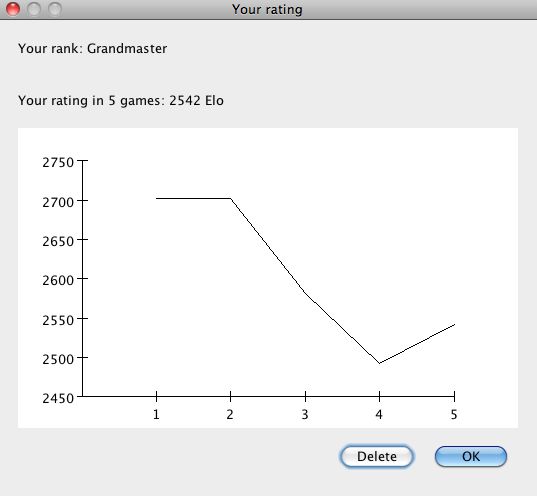Hey, I won another cool game against Shredder! Even though I know it doesn’t mean anything, I still feel like sharing.
I was White in the position below:
 Position after 31. … Re5. White to move.
Position after 31. … Re5. White to move.
FEN: 3q2k1/1p1n1p2/r2p1Pp1/p1p1r1N1/P1P1PQP1/3P4/1P3R2/R6K w – – 0 32
Here, believe it or not, I was feeling just a bit frustrated. Yes, I’m a pawn up and with a much superior position, thanks to the “bone in the throat” f-pawn and the dangerous threats along the h-file. However, I was starting to think that I had screwed up my chances for a clean knockout. I wanted to play 32. R1f1, but then I thought Black might be able to play 32. … Nxf6, winning a pawn because of White’s dangling knight on g5. Alternatively, I could play 32. Nf3, but this seemed like a retreat. I couldn’t see a definite win after 32. … Re6 33. g5 Kf8 34. Rh2 Ke8. Or Black could give up the exchange but eliminate the “bone in the throat” with 32. … Qxf6 33. Qxf6 Nxf6 34. Nxe5 de.
In fact, I think that either 32. R1f1 or 32. Nf3 would have been fine, but suddenly, like the Grinch, I “had an idea. An awful idea! The Grinch had a wonderful, awful idea!” Do you see what it is?
Here’s the answer:
32. Nh7!!
The answer to all of my prayers! First, it protects the “bone in the throat” pawn at f6. It keeps the king from running away to f8 and e8. It also keeps the queen from coming to f8 to defend mates on g7. And finally, the knight is taboo because of 32. … Kxh7? 33. Rh2+ Kg8 34. Rh8+!! Kxh8 35. Qh6+ Kg8 36. Qg7 mate.
The point of the knight-and-rook sacrifice is, of course, to lure the king to h8 so that the queen will come to h6 with check, and Black won’t have time to take on f6.
After this shot Black can only delay the inevitable. The computer played
32. … d5 33. Qh6! Nxf6 34. Nxf6+ Qxf6
A sad necessity. 34. … Rxf6 would be met by 35. Rh2 threatening mate on h8.
35. Rxf6 Rxf6 36. Kg2 dc 37. Rh1 resigns
Mate is coming on the h-file anyway.
I’ve noticed before that Shredder tends to underestimate the danger of giving me control over an open h-file when it is castled kingside. I’d even go so far as to say that attacks along the h-file are its Achilles heel. Unfortunately, the percentage of games where I am able to get such an attack is pretty small. The stars have to align.
Just for fun, here is a printout of my “rating graph” against Shredder, showing me scoring three wins and two draws in five games with its rating set at 2302. So my performance rating for the five games is 2542 — grandmaster strength! In more than 1000 games against it, I’m pretty sure that this is the first time I have ever had such a good five-game streak.
(Can you believe I’ve played a thousand games against my computer? I need to get a life.)




{ 8 comments… read them below or add one }
Dana, you don’t need to get a life; you’re doing great. You know who needs to get a life? – the guy I played on Playchess.com. He’s been a member for 13 years, has played over 90,000 games, and has a rating under 1400, and he’s not unusual. Jesse Krai said that your chess will never improve if all you do is play blitz games and Playchess proves it; most of the members are the walking dead, zombies who play blitz after blitz. I must say that I’m almost just as bad, truth be told. The deep beauty of chess reveals itself in slow, contemplative play of the kind that you describe here.
https://timkr.home.xs4all.nl/chess2/honor.htm
You should try some of the Nemeth’s recipes.
My first thought was that these recipes probably wouldn’t work any more because the programs were so ancient. Shredder 5? Fritz 6? However, on second thought maybe they would. After all I’m playing Shredder deliberately “dumbed down” to 2302, so that might be very similar to playing Shredder 5.
What’s definitely true is that the same tendency that Nemeth observed is still there. He exploited it by playing to open the h-file every game, with … h5 and … Bg4 and waiting for Shredder to play h3 and take the bishop. The version of Shredder I’m playing, Shredder 13, is still far too willing to open the h-file. What happened in this game was typical: I played h3 and g4, it played … h5 (the move order may vary) and instead of keeping the position closed with … h5-h4 it opened the file with … h5xg4.
Hello,
I’ve been following your blog for quite some time but I never commented. I’ve started playing training games against Shredder too. I usually give myself 15 minutes + 30 seconds per move and give the computer 15 minutes for the whole game. I’m wondering: when I set the playing strength at say 2200 and the time at 15 minutes. Will the computer play like a 2200 player in rapid chess or will the moves be the moves a 2200 player would play in a longer game too?
More generally I would be very curious how they program a computer in such a way that you can turn one knob (metaphorically speaking) and change the strength. My leading guesses are that it works by increasing the probability that the computer will play the second-best or third-best move; or that it works by changing the depth of analysis. There’s an old rule of thumb that says one ply of analysis is worth about 200 rating points. If that’s true, you can change the machine’s skill level in a relatively predictable way just by slowing it down slightly.
So my answer would be that the computer set at 2200 and playing rapid chess would be weaker than the computer at 2200 and playing a slow time control. Because rapid chess has the same effect, reducing the depth of analysis.
However, a computer set at 2200 will never play like a human 2200 player. It may be equally strong, but its mistakes will be different.
Yes, it makes sense. By the way, here is a link to a game I won today against Shredder 13 (set at 2205): http://isolated-pawn.com/?p=84
By the way I just played a game against Shredder 13 in which I used your pet opening (1.e4 e5 2.Nf3 Nc6 3.Bb5 Nd4) for the very first time. I’d be very curious to hear your thoughts on this game: http://isolated-pawn.com/?p=90
The following post:
https://chess.stackexchange.com/questions/7690/how-does-a-chess-engine-mimic-an-elo-rating
claims that for Stockfish, weakening involves adding a random number to the score of each move before choosing the best move. The greater the weakening, the larger the spread of the random numbers. In this case, there is not an obvious difference between rapid and slow chess as the search proceeds just the same and only move selection is affected.
It’s interesting that the randomizer is added, not multiplied. My intuition says that a multiplicative random factor *would* behave differently in rapid chess, but I can’t prove it.